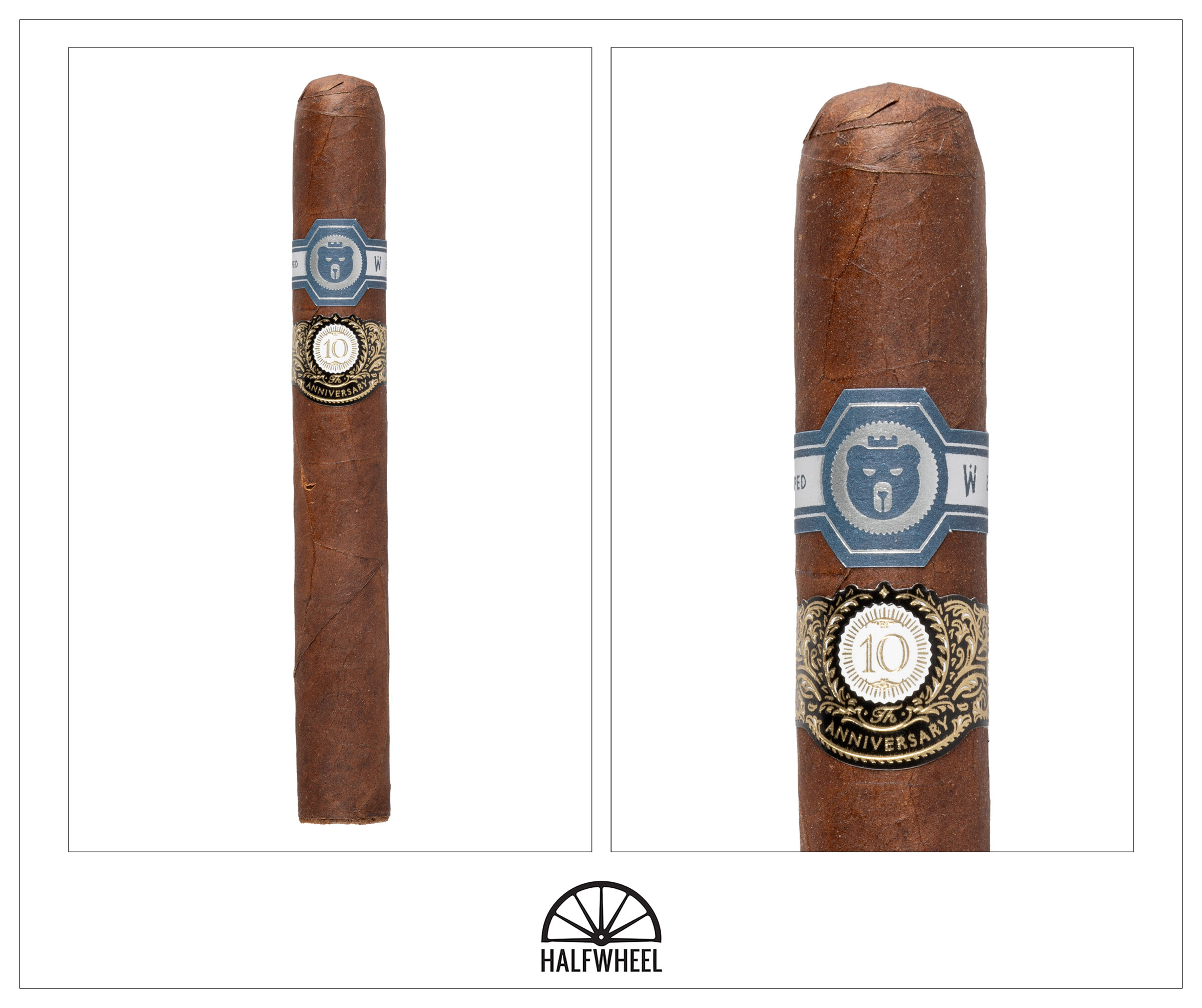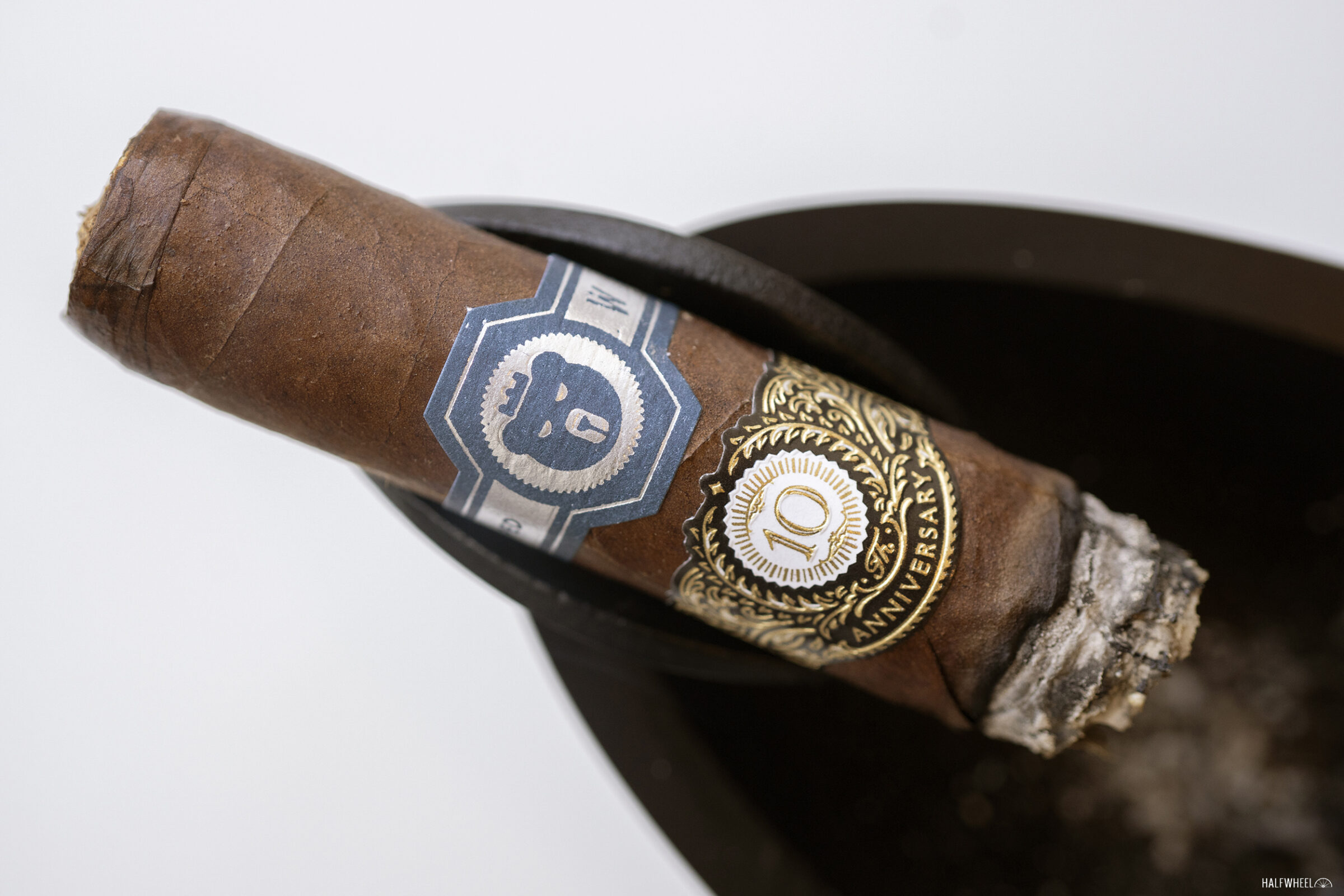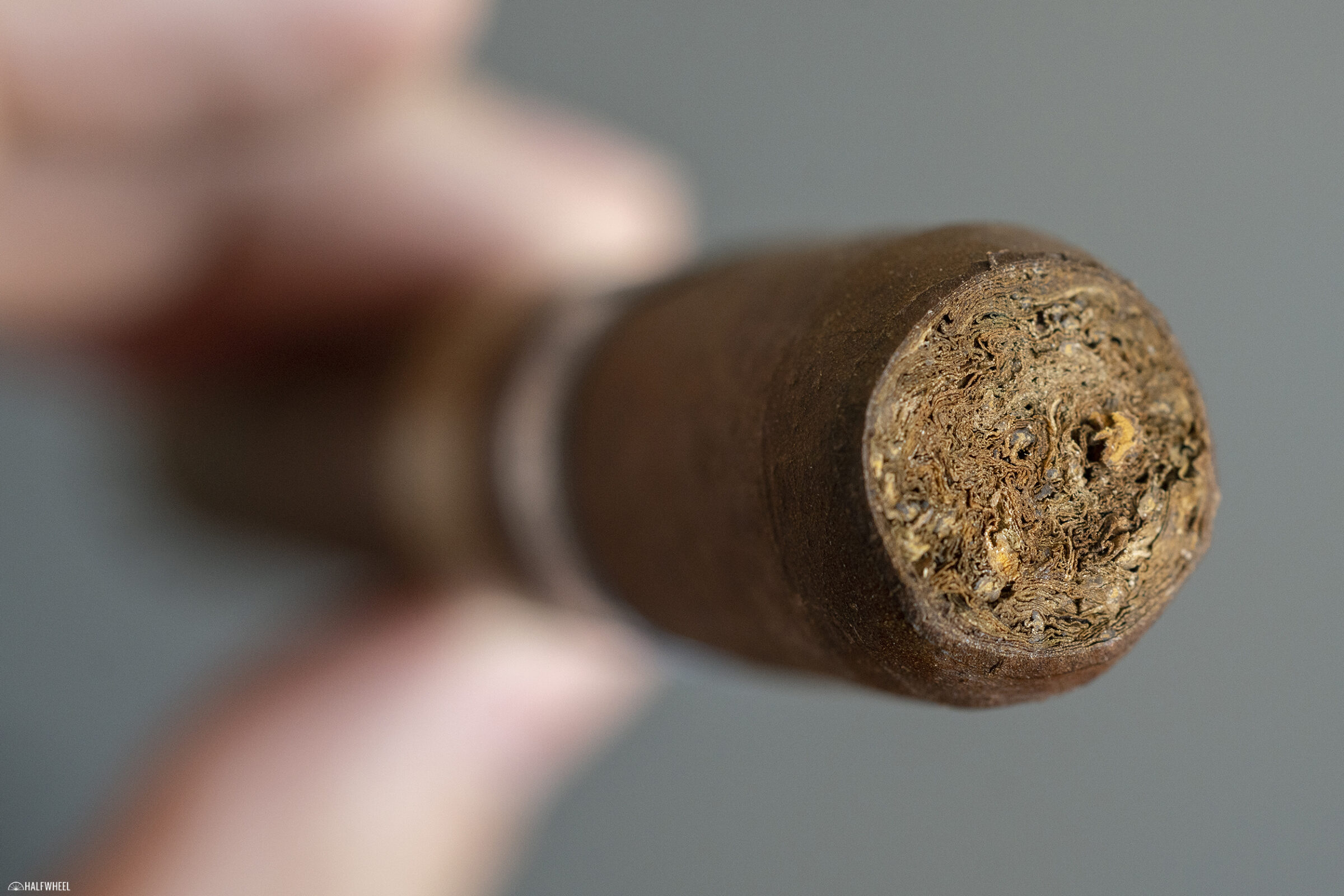While Warped Cigars wasn’t born in 2014, it was reborn in 2014.
The brand was started by Kyle Gellis in 2008 but took a hiatus as Gellis finished school. If you were an avid cigar smoker—maybe even a reader of halfwheel’s predecessors, Smoking Stogie and TheCigarFeed—you’d be forgiven for not knowing about Warped circa 2010. While the brand had a following on some cigar forums, it was not something that was sold nationally.
In 2014, Warped changed that by heading to the 2014 IPCPR Convention & Trade Show with a new look, new lines and seemingly a new purpose. I still remember that booth in 2014, which was fully enclosed and reminded me of a small boutique that could be found in the middle of the Las Vegas airport. Not only was the booth well-designed, but the company’s new brands had a design execution that wasn’t prevalent.
As part of its relaunch, Warped introduced a handful of new brands, three of which are getting celebratory 10th anniversary cigars this year: Don Reynaldo, El Oso and La Colmena.
El Oso—Spanish for the bear—was the first of those three lines to be released in 2014 and is also the first of the trio to get its 10th anniversary cigar. That cigar is called the El Oso Grand Papa, a 6 x 50 toro. It uses a blend that is different from the regular El Oso line: an Ecuadorian habano oscuro wrapper over a Nicaraguan binder and fillers from the Dominican Republic and Nicaragua. The regular El Oso blend line uses an Ecuadoran binder.
Like the rest of the El Oso line, the Grand Papa is made at El Titan de Bronze in Miami.
As for the other two 10th anniversary cigars. The Don Reynaldo Grand Reynaldo 10th Anniversary, also a 6 x 50 toro, just began shipping to stores and the La Colmena 10th Anniversary cigar is scheduled to ship this fall.

- Cigar Reviewed: El Oso Grand Papa
- Country of Origin: U.S.A.
- Factory: El Titan de Bronze
- Wrapper: Ecuador (Habano Oscuro)
- Binder: Nicaragua
- Filler: Dominican Republic & Nicaragua
- Length: 6 Inches
- Ring Gauge: 50
- Vitola: Toro
- MSRP: $25 (Box of 10, $250)
- Release Date: Feb. 19, 2024
- Number of Cigars Released: 1,500 Boxes of 10 Cigars (15,000 Total Cigars)
- Number of Cigars Smoked For Review: 3
The El Oso Grand Papa has a delicious-looking dark brown wrapper with plenty of red hues breaking through the matte texture. While the cigar photographed in the studio has some sort of nick, the three cigars used for the review avoid any that issue. That’s not to say the cigars are flawless; one has a noticeably loose seam, and all three have obvious, large hard spots. These cigars don’t come in cellophane, though I can still find a relatively full aroma from the wrappers, with one cigar more medium-full. All three have a pungent ammonia smell over scents of apple skin and barnyard. The feet have a much softer aroma with the smell of French bread—one cigar is more like a salted cracker—over some hickory, leather and green pepper. Intensity-wise, the aromas of the feet range from medium to medium-full. The first cigar has a very tight cold draw with flavors of Cap’n Crunch cereal and something that reminds me of the broth of tonkatsu ramen over green pepper and metallic flavor. The second cigar has a somewhat loose draw with some muted Cap’n Crunch flavors leading peanut butter, acidity, barnyard, white pepper and a touch of floral flavors. In a bit of a Goldilocks’ moment, the third cigar has a good draw as far as tightness. It has sweet, fruity flavors that remind me of sugary, orange or pineapple-flavored juice drinks, with cinnamon and earthiness in the background.
A lot of times, the draw will physically change once the cigar is lit. Unfortunately, the first and third El Oso Grand Papas I smoke start with very tight draws. Flavor-wise, there’s lots of charred earthiness and toastiness with secondary notes of cauliflower, sawdust, black pepper and some sweetness underneath. The second cigar has a somewhat loose draw with earthiness, coffee and nuttiness leading cinnamon, leather and a crisp starchiness flavor. All three cigars start around medium-full. Flavor-wise, earthiness leads the dance with oak and other woods behind it. While black pepper isn’t the strongest flavor, it outlasts all of the others, making it the most inescapable flavor. The finish has black pepper all around the tongue—and again, it outlasts the other flavors—with leather, earthiness, nuttiness and creaminess as secondary flavors. Retrohales are a mixed bag, as some puffs will deliver sunflower seeds, earthiness, oak and creaminess—my favorite part of the first third—while other puffs have a bitter flavor that reminds me of the smell of new carpet. The finish adds some sugary sweetness and a tingle to the earthiness. The flavor is full, body is medium-full and strength is medium. I find the flavor profile to be aggressive, though seemingly restrained by a ceiling. It’s almost like a car that is going 120 mph but cannot go any faster. I keep waiting for it to enter a new level of aggressiveness, but it never comes. All three cigars have draw issues. The first cigar is the worst as it is nearly plugged. The second cigar has a loose draw, and the third cigar has a very tight draw, though not as bad as the first one. The poor draws require me to be more attentive to each cigar, though the smoking pace is far more frequent than normal.
By the second third of each cigar, draw problems are dominating my mind. Flavor-wise, it’s similar to the first third but slightly more restrained, albeit not restrained. Rich and thick earthiness along with woodiness are the strongest flavors, with toastiness, leather and sweetness serving as secondary notes. Like before, black pepper stands out as being the flavor that is present for the longest amount of time, outlasting nearly every other flavor sensation. During the finish, sweetness kicks in for a second or two before a charred toastiness and black pepper take back over, although one cigar has some added red pepper. Retrohales continue to deliver my favorite part of the profile as there’s a crisp pistachio mixed with some generic potato starchiness over roasted and floral flavors. While there’s no pepper for the first few seconds, once the finish kicks in, toastiness and red pepper outlasts everything. Flavor is full, body ranges from medium-plus to full and strength is medium-full, though it gets closer to full on all three cigars. I’m not satisfied with the draws on any of the three cigars, though I think only the first cigar—the tightest of the draws—is actively getting worse. All three cigars require at least one touch-up, though the most problematic experience is the second cigar, which requires multiple touch-ups before a full relight.
The best of the three cigars is the final one, which is able to keep more of the existing flavor profile than the other two cigars. Most of the time, it’s an aggressive mixture of woodiness and red or black pepper, which isn’t being helped by the declining combustion performance. At times, there can be a deviation—a mushy sandwich bread flavor, paprika, a subtle rum-like sweetness—but the combustion issues are causing the cigars to have more pepper and more sharpness. The first cigar is outright bitter, far and away the worst of the bunch, though the second cigar tastes like a cigar that has had multiple relights. The bread can play a larger part during the finish, but as has been the case from the start, the black pepper outlasts everything. Flavor is full, body is medium-plus to full and strength is now solidly full, a very quick ramp-up compared to where each cigar was around the halfway mark. Fortunately, the first cigar’s draw seems to be getting better during the final third. It’s still not as good as the third cigar—the other cigar with a tight draw—and it’s still objectively bad, but at least it’s not getting worse. The second cigar’s loose draw prevents it from consistently burning, and the third cigar—the best of the bunch—requires multiple touch-ups, though it avoids going completely out.
Final Notes
- If you had to rate the likelihood that a given factory’s cigar will have a serious construction issue on a scale of 1-10, with 1 representing either 9 or 10 out of 10 cigars don’t have a serious issue and 10 representing 10 out of 10 cigars had a serious construction issue. How many factories would you rate with a lower or the same number as five years ago?
- If you asked me that question about 50 factories, I would guess the answer would be around five. A lower number or the same number means the likelihood of error didn’t increase. It seems every factory is at least a bit more likely to screw up a cigar than before. It doesn’t mean the majority of cigars have issues, and I don’t think that’s the case, but it’s more likely that a given factory is making errors than it was five years ago.
- What I cannot figure out is why now. I understood the increase in frequency during 2020 and 2021 when factories were dealing with lockdowns and labor issues. I don’t understand why it’s now worse than that.
- To put some numbers behind it, this is the 13th full review of a new cigar that I’ve done in 2014: eight of them have scored 85 or lower. Last year, the average score for reviews I published was 85.58. Not every one of these sub-86 scores was due to construction issues, but almost all of them were.
- These three cigars had some of the poorest construction and construction scores of any cigar I’ve reviewed of late. Quite simply, there wasn’t a single five-minute stretch during any of the cigars when I was satisfied with the construction.
- The first cigar was quite firm with hard spots throughout the cigar. With many of the hard spots, it’s only hard on one side, but if I rotate the cigar, I typically can find a less firm spot. This particular cigar had a large hard spot that ran slightly above the main band to the bottom of the secondary band—more than an inch—that was hard all the way around.
- Upon cutting the first cigar and taking a cold draw, I was concerned enough to take this picture. Between the obvious hard spots, the cold draw’s resistance and the appearance of the bunch suggested that this cigar was packed too tightly. One thing that didn’t emerge—on any of the three cigars—was visible tar, which I would have expected on the first cigar and wouldn’t have thought twice about had it shown up on the third cigar.
- For those who see the above picture and think that I should just remove the “stems” to fix the problem, a few thoughts:
- From my experience, doing so might make the cigar better, it might also make it worse. There’s no way to know.
- As for whether the “stems” should be there in, they should. These are not the stems of the leaves, i.e. the center vein. The center vein of a leaf is much larger and gets removed before the cigar is rolled. If that was in a cigar, I’d be concerned.
- The “stems” you see here are the veins that run horizontally on the leaf. I’ve never known a cigar factory to remove these veins as it would be incredibly time-consuming and would damage the leaves. I wouldn’t really call the “stems” as I think that should refer to a specific part of the plant. That said, I don’t begrudge anyone who calls them “stems” as it makes sense.
- The second had an open draw that caused issues, albeit not as many as the first cigar. The third cigar was too tight but not plugged. For the record, I generally like a slightly tighter draw.
- Regardless of whether the draw was tight or loose, the ash was incredibly firm and difficult to get off the cigar.
- Nearly every press release we get regarding a cigar made at El Titan de Bronze mentions that the factory uses Level 9 rollers. The Cuban factories used to rate rollers at different levels, the highest of which was Level 9. Quite some time ago, Cuba stopped giving out Level 9 ratings, meaning Level 8 became the highest.
- I’ve felt that Level 9 thing was always overblown. If nothing else, I don’t think of El Titan de Bronze as a factory producing cigars with noticeably fewer or more construction issues than the norm. Quite frankly, I only think of a few factories as being able to consistently deliver good across-the-board construction where, say, only 1 out of 10 cigars has a serious construction issue. Cigars Davidoff and JRE’s Fábrica de Puros Aladino at Las Lomas Jamastran.
- I noticed that the wrappers didn’t fully cover the foot. I can’t tell if it’s an intentional feature. This is not like RoMa Craft Tobac’s Intemperance cigars, which have a small amount of the binder exposed. Rather, this was a tiny amount of binder exposed that wasn’t all that obvious unless I looked straight down at the cigars, but it was present on each cigar.
- These cigars are listed at a 6 x 50. At the time these cigars were measured, we weren’t marking which cigar was which, meaning I don’t know which order I smoked the cigars. We’ve now started doing that.
- Given the extreme aberration, I re-weighed the second cigar and confirmed what the scale said the first time. To put the weight difference between the second and third cigars into perspective, it’s almost the weight of the Davidoff Winston Churchill The Late Hour Petit Panetela that Brooks recently reviewed.
- While the weight can be a useful data point, it’s not as simple as one cigar had way more tobacco than the other two. It’s possible that the cigars had the same amount of tobacco as measured in volume, but the moisture content of one cigar’s tobacco was much higher. It is entirely possible that the second cigar was overpacked.
- Cigars for this review were purchased by halfwheel.
- Final smoking time for the plugged cigar was two hours and 20 minutes. Final smoking time for the second cigar was under two hours.
While I think I know what this cigar is supposed to taste like, I cannot be sure. One cigar was plugged, another had a very tight draw and the third had a draw that was far too open. If properly rolled, I’d expect the El Oso Grand Papa to be able to deliver that aggressive woody and earthy profile, though perhaps with a bit more finesse than what I was able to find consistently. As I write way too often in reviews, if the cigars aren’t put together properly, they aren’t going to smoke properly. That’s the case here.








